
CSS Albemarle was a steam-powered casemate ironclad ram of the Confederate Navy, named for an estuary in North Carolina which was named for General George Monck, the first Duke of Albemarle and one of the original Carolina Lords Proprietor.

CSS Tennessee was a casemate ironclad ram built for the Confederate Navy during the American Civil War. She served as the flagship of Admiral Franklin Buchanan, commander of the Mobile Squadron, after her commissioning. She was captured in 1864 by the Union Navy during the Battle of Mobile Bay and then participated in the Union's subsequent Siege of Fort Morgan. Tennessee was decommissioned after the war and sold in 1867 for scrap.
The CSS Beaufort was an iron-hull gunboat that served in North Carolina and Virginia during the American Civil War. Originally launched as Caledonia at Wilmington, Delaware, in 1854, the ship was owned by James Cathcart Johnston. It saw use as a tugboat on the Dismal Swamp Canal. On July 9, 1861, Beaufort was commissioned into the navy of the state of North Carolina for use in the American Civil War. First serving on the North Carolina coast, Beaufort was present at the battles of Roanoke Island and Elizabeth City in February 1862. Escaping the Confederate defeat at Elizabeth City via the Dismal Swamp Canal, Beaufort reached Norfolk, Virginia, where she joined the James River Squadron.
The Battle of Sewell's Point was an inconclusive exchange of cannon fire between the Union gunboat USS Monticello, supported by the USS Thomas Freeborn, and Confederate batteries on Sewell's Point that took place on May 18, 19 and 21, 1861, in Norfolk County, Virginia in the early days of the American Civil War. Little damage was done to either side. By the end of April 1861, USS Cumberland and a small number of supporting ships were enforcing the Union blockade of the southeastern Virginia ports at the southern end of the Chesapeake Bay and had captured several ships which attempted to pass the blockade. USS Monticello's bombardment of the Sewell's Point battery was one of the earliest Union Navy actions against Confederate forces during the Civil War. While it has been suggested by some sources that the Monticello's action may have been the first gunfire by the Union Navy during the Civil War, a brief exchange of cannon fire between the U.S. gunboat USS Yankee and shore batteries manned by Virginia volunteer forces which had not yet been incorporated into the Confederate States Army at Gloucester Point, Virginia on the York River occurred on May 7, 1861.
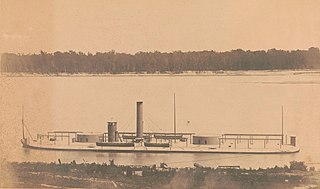
USS Chickasaw was an ironclad Milwaukee-class river monitor built for the United States Navy during the American Civil War. The ship participated in the Battle of Mobile Bay in August 1864, during which she was lightly damaged, and the bombardments of Forts Gaines and Morgan as Union troops besieged the fortifications defending the bay. In March–April 1865, Chickasaw again supported Union forces during the Mobile Campaign as they attacked Confederate fortifications defending the city of Mobile, Alabama.
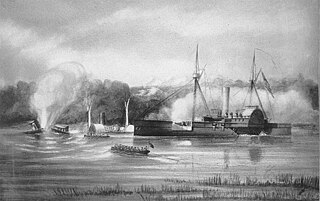
USS Wyalusing was a double-ended, side-wheel gunboat that served in the United States Navy during the American Civil War. She was named for the borough of Wyalusing in Bradford County, Pennsylvania.
Alexander S. Crawford was a sailor in the United States Navy who served in the American Civil War. He received the Medal of Honor for his actions during the war.
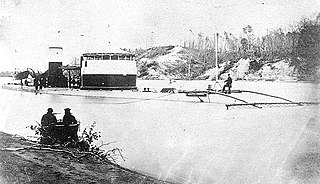
USS Saugus was a single-turreted Canonicus-class monitor built for the Union Navy during the American Civil War. The vessel was assigned to the James River Flotilla of the North Atlantic Blockading Squadron upon completion in April 1864. The ship spent most of her time stationed up the James River where she could support operations against Richmond and defend against a sortie by the Confederate ironclads of the James River Squadron. She engaged Confederate artillery batteries during the year and later participated in both attacks on Fort Fisher, defending the approaches to Wilmington, North Carolina, in December 1864 – January 1865. Saugus returned to the James River after the capture of Fort Fisher and remained there until Richmond, Virginia, was occupied in early April.
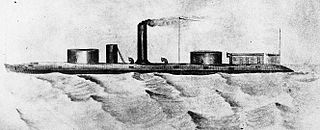
USS Winnebago was a double-turret Milwaukee-class river monitor, named for the Winnebago tribe of Siouan Indians, built for the Union Navy during the American Civil War. The ship participated in the Battle of Mobile Bay in 1864, during which she was lightly damaged, and the bombardments of Forts Gaines and Morgan as Union troops besieged the fortifications defending the bay. In early 1865, Winnebago again supported Union forces during the Mobile Campaign as they attacked Confederate fortifications defending the city of Mobile, Alabama. She was placed in reserve after the end of the war and sold in 1874.

The Battle of Albemarle Sound was an inconclusive naval battle fought in May 1864 along the coast of North Carolina during the American Civil War. Three Confederate warships, including an ironclad, engaged eight Union gunboats. The action ended indecisively due to the sunset.

USS Mahopac (1864) was a Canonicus-class monitor built for the Union Navy during the American Civil War. The vessel was assigned to the James River Flotilla of the North Atlantic Blockading Squadron upon completion in September 1864. The ship spent most of her time stationed up the James River where she could support operations against Richmond and defend against sorties by the Confederate ironclads of the James River Squadron. She engaged Confederate artillery batteries during the year and later participated in both the first and second battles of Fort Fisher, defending the approaches to Wilmington, North Carolina, in December 1864 – January 1865. Mahopac returned to the James River after the capture of Fort Fisher and remained there until Richmond, Virginia was occupied in early April.

Black Warrior is the name of a Confederate two-masted schooner that participated in the defense of Roanoke Island in North Carolina during the Civil War. Its brief wartime career ended with its burning at Elizabeth City, North Carolina.
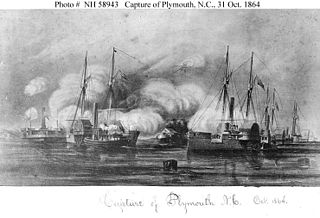
The Battle of Plymouth was an engagement during the American Civil War that was fought from April 17 through April 20, 1864, in Washington County, North Carolina.
USS Curlew was a Union Navy stern-wheel steamer that saw service during the American Civil War. Built in 1862 in Pennsylvania as a civilian vessel, she was purchased by the Union Navy on December 17, 1862. Converted into a tinclad warship, she saw service from 1863 to 1865, often serving on the Mississippi River, the Ohio River, and the Tennessee River. In May 1863, she was involved in a minor action against Confederate forces on the Mississippi River off of the shore of Arkansas. July saw Curlew take part in an expedition up the Red River of the South, the Tensas River, the Black River, and the Ouachita River that captured two steamers and destroyed two more and a sawmill. On May 24, 1864, she dueled with Pratt's Texas Battery while on the Mississippi River, and on November 4 of that same year, was near the action of the Battle of Johnsonville but was unable to join the fighting. Decommissioned on June 5, 1865, she was sold in mid-August and her further career is unknown.
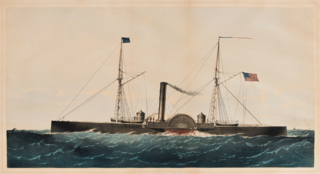
USS Osceola was a wooden, sidewheel Sassacus-class gunboat which saw combat with the Union Navy in the American Civil War. She was designed with shallow draft and double-ends specifically to allow her to operate in the narrow rivers and inlets along the Confederate coast. She was well suited to this role and took part in major battles on the James and Cape Fear Rivers.
USS Tristram Shandy was a 444-ton steamer and blockade runner captured by the Union Navy during the American Civil War.
USS Shamrock was a large seaworthy steamer with powerful guns, acquired by the Union Navy during the American Civil War. She was used by the Union Navy as a gunboat in support of the Union Navy blockade of Confederate waterways.

Captain Robert Townsend was a Civil War-era ship captain in the United States Navy. He served twice, once before the war then again during the war. He saw active combat while serving aboard three ships, most notably as commander of the USS Essex from 1863 to 1864, an ironclad gunship on the Mississippi River. Captain Townsend died of heatstroke while commanding the USS Wachusett in China in 1866, and is buried in Albany, New York.

The Battle of Trent's Reach was one of the final major naval battles of the American Civil War. Beginning on January 23, 1865, a powerful flotilla of Confederate warships bombarded Fort Brady along the James River and engaged four Union Navy ships with the intention of breaking through the blockade to attack City Point, the base of General Ulysses S. Grant who was besieging Petersburg, Virginia. After two days of fighting, the rebels withdrew back up the river without completing their objectives.













